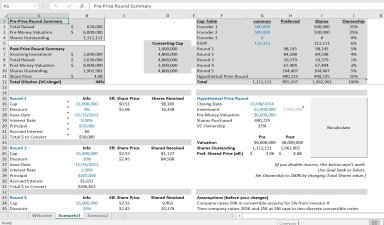
Last version published: 31/08/2017 10:47
Publication number: ELQ-38313-2
View all versions & Certificate

Cap Table Excel Template for Pre Series A Companies
How to Make a Cap Table for a Pre Series A Fundraising Round
Further information
How to read the spreadsheet:
-> Whenever you see a red triangle, hold your mouse over it for an explanatory comment.
-> Blue text are inputs. Edit those and the other cells will update accordingly.
-> Each time you edit a scenario (set of blue fields), you should run Goal Seek (or Solver for the Excel purists) for an accurate result. Calculating the final dilution is an iterative exercise. Or simply enable macros and use the Recalculate button.
How do you know you have an accurate calculation? The value in cell J11 (Total Ownership) should be very close to 100% (+/- 0.5% error).
In additional to summary values at the top, columns Ownership (%), and Share Value ($) deserve extra attention.
Having come across equity grants at dozens if not hundreds of companies, we know there is no one-size-fits-all formula, but the spreadsheet is meant to be a starting point. If it does the trick as is (and it should for the majority of you), consider yourself lucky for having a simple cap-table. It will only get messier as the business grows.
Some Advice From EquityZen:
Do your best to keep a clean cap-table. What defines a clean cab-table?
-> A minimal amount of Angel/Friends+Family investors (ie: two $50k Angels are better than ten $10k F&F Investors)
Minimal different equity Series (and therefore less permutations of outcomes for your investors)
A clean cap-table will make your company more attractive to VC investment. If you only have two different forms of equity (founders' common stock and Seed Preferred), any future investor can very quickly conclude their payout in an exit. However, if there are multiple series of equity (and therefore multiple liquidity preferences, sets of voting rights, information rights, etc), that calculation becomes a whole lot messier and could be the difference between a 7-digit investment and a VC passing on you.
The same goes as an acquisition target: messy cap tables will scare off potential suitors, as they'll realize they have a lot of operational work involved to complete the acquisition.
Disclaimer:
This post and sample cap table spreadsheet is provided as a learning tool on an as-is basis with no guaranties. We are not lawyers and this post should not be considered advice legal, tax, or otherwise. We recommend you consult your counsel and tax specialist before making final decisions.
(This article originally appeared on EquityZen, an investment platform bringing private markets to the public.
URL: https://equityzen.com/blog/pre-series-a-cap-table-template/?utm_source=eloquens.com&utm_medium=article)



